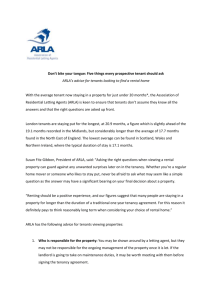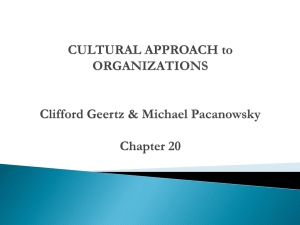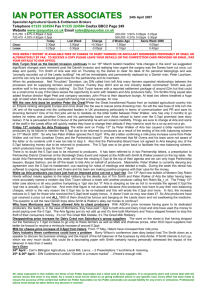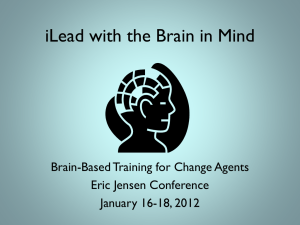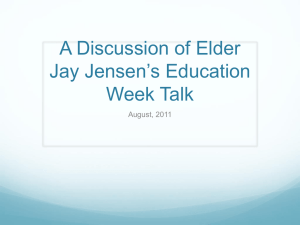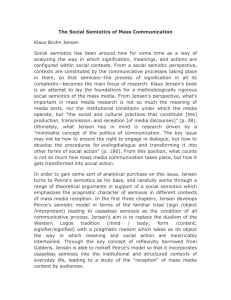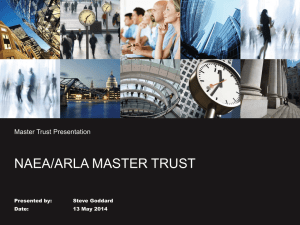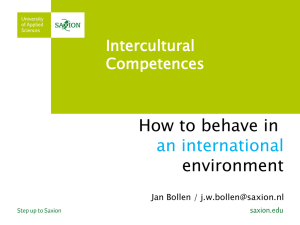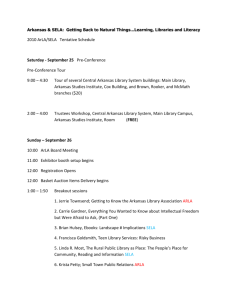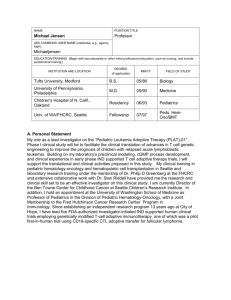Intercultural Market Communication 1_student copy
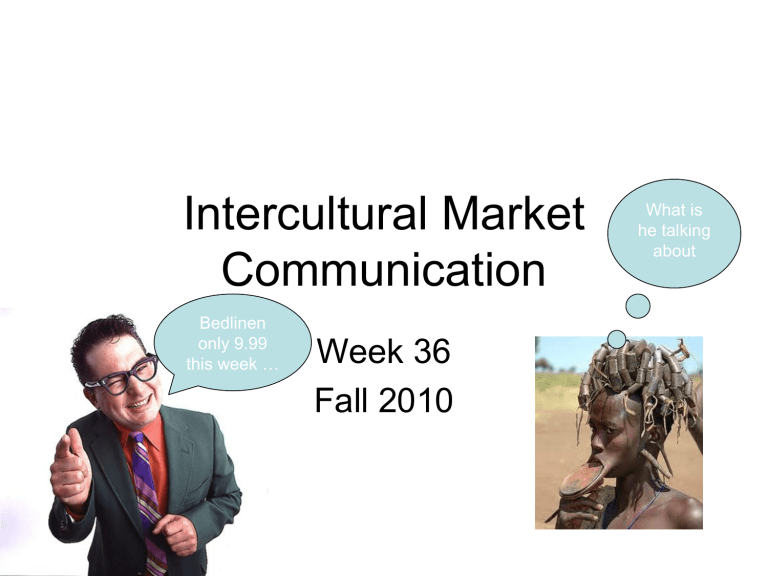
Intercultural Market
Communication
Bedlinen only 9.99 this week …
Week 36
Fall 2010
What is he talking about
Practical
• Who am I?
• Who are you? Photos
• What is Intercultural Market
Communication all about?
• Exam
• In English, please
Today
• Course introduction
• Lecturer’s presentation, discussions
• Please read: M&M, ch. 1; U&L ch. 3
• Group work based on questions 1, 2 and 3 in M&M
• Presentation of Assignment 1
• Academic Writing – presentation and discussion
What is culture?
• Culture theory
• Sociolinguistics
• Anthropologists – Alfred L. Kroeber and
Clyde Kluckhohn
• Social semiotics
Functionalist vs. interpretivist
• From Hofstede and Hall to Geertz
• From predictive patterns of thinking and behaving to the complexity of overlapping, changeable small cultures
Functionalist
• Hofstede - dimensions
• Hall - context and time
Geert Hofstede’s 5 dimensions
"Culture is more often a source of conflict than of synergy.
Cultural differences are a nuisance at best and often a disaster."
Dr. Geert Hofstede http://www.geert-hofstede.com/
Exercise:
• What does it mean to be Danish?
• Please give me examples of a painting, a photograph, a person, a thing, a text, a song or piece of music, a poem, a dish, a place, an occation
Edward Hall: Context
(high/low)
...
Overtness of messages
Locus of control and attribution for failure
Many covert and implicit messages, with use of metaphor and reading between the lines
Inner locus of control and personal acceptance of failure
Much nonverbal communication Use of non-verbal communication
Expression of reaction Reserved, inward reactions
Many overt and explicit messages that are simple and clear. Overtness of messages
Outer locus of control and blame of others for failure
More focus on verbal communication than body language
Visible, external, outward reaction
Cohesion and separation of groups
People bonds
Level of commitment to relationships
Flexibility of time
Strong diistinction between ingroup and outgroup.
Strong sense of family
Strong people bonds with affiliation to family and community
High commitment to long-term relationships. Relationship more important than task
Time is open and flexible. Process is more important than product
Flexible and open grouping patterns, changing as needed
Fragile bonds between people with little sense of loyalty
Low commitment to relationship. Task more important than relationships
Time is highly organized. Product is more important than process
Edward Hall: ... and time
Monochronic Culture Polychronic Culture
Interpersonal Relations
Activity Co-ordination
Task Handling
Breaks and Personal Time
Temporal Structure
Work/personal time separability
Organizational Perception
Interpersonal relations are subordinate to present schedule
Schedule co-ordinates activity; appointment time is rigid
One task at a time
Breaks and personal time are sacrosanct regardless of personal ties
Time is inflexible; time is tangible
Work time is clearly separable from personal time
Activities are isolated from organization as a whole; tasks are measured by output in time (activity per hour or minute)
Present schedule is subordinate to interpersonal relations
Interpersonal relations coordinate activity; appointment time is flexible
Many tasks are handled simultaneously
Breaks and personal time are subordinate to personal ties
Time is flexible; time is fluid
Work time is not clearly separable from personal time
Activities are integrated into organization as a whole; tasks are measured as part of overall organizational goal
(Adapted from http://stephan.dahl.at/research/online-publications/intercultural-research/halls-classic-patterns/ )
Criticism
• Other identity factors than culture (as nationality): Age, gender, race, religion, family patterns, education, occupation.
• Various identities at home, at work, over time, etc.
• Ethnocentrism
• Determinism
• Stereotyping
Interpretive
• Clifford Geertz – webs of significance – thick description
• Victor Turner
• Etic/emic – Kenneth Pike
Clifford Geertz
• Webs of significance
Geertz:
"Believing, with Max Weber, that man is an animal suspended in webs of significance he himslef has spun, I take cultures to be those webs, and the analysis of it to be therefore not an experimental science in search of law but an interpretive one in search of meaning."(1973)
• Thick description - Geertz’ Balinese cockfight example - almost like being there
Criticism
• Utility - degree of usefulness
• Relativism
• Idealism
Group work
• Main differences between approaches?
• Define web of significance. How does it relate to intercultural communication?
• What is national identity?
Assignment 1
1.
Take a close look at Arla’s international website www.arla.com
to see in which countries Arla operates. Then identify some of the intercultural communication challenges that Arla faces operating in a globalised world. Please, discuss.
2. How should Arla deal with the intercultural communication challenges that you have identified above? Please, discuss.
3. What could other companies learn from Arla about operating across cultures?
Assignment 1
continued
Practical stuff when working on this assignment:
1.
Check spelling and grammar
2.
Answer all questions
3.
Provide notes when you quote, paraphrase and refer to someone else’s words and opinions
4.
Find facts, articles, etc. to support your case
5.
Search for information on the internet, in other works of literature, etc. (remember references)
6.
Use meta-language – tell what you’re doing and why
7.
Be cohesive – demonstrate a logical flow
8.
Demonstrate that you understand relevant theoretical issues and that you can use them in your argumentation
9.
Everything is up for discussion, so please discuss
10. Remember this is an academic paper
11. Deadline: Session 3 – 23 September
12. Write no more than 10 pages per group (the final exam will be up to 6 pages per person)
A
Group 1:
• Astrid Hedermann
Pedersen
• Katrine Bæk Larsen
• Eva Bøge Josefsen
• Mette Bruun Sørensen
• Janni Ank Mertz
Group 5:
•Christina Thomsen
•Sanne Skov Iversen
•Trine Nielsen
•Hanne Kragh
•Anastasia F. X. Hjorth
Group 2:
• Steffen Berg Jensen
• Christina Nielsen
•
Maren Bork Villadsen
• Mariann Daugaard
•
Mads Boye Holst
Group 6:
•Lise Anna Kløcker Grove
•Anne Sofie Weiersøe
Skovholm
•Kathrine Ærthøj Kanne
Pedersen
•Kristian Skriver Jensen
•Martin Norup Thomsen
Group 3:
• Pia Bloch Mikkelsen
• Ragnheidur
Georgsdottir
• Jeanette Kjær Olsen
•
Julie Veggerby Jensen
• Janne Hougaard
Rasmussen
Group 7:
•Kathrine Frost Eriksen
•Jesper Skov Christensen
•Anja Rank Jensen
•Christina Kirk Kjærsgaard
Group 4:
• Mads Steen Hebbelstrup
• Patrick Hoban
•
Ellen Kraaijenzank
• Fawzie El-Fil
•
Trine Moesgaard
Thomsen
Group 8:
•Janni Lanzky Jensen
•Anja Hansen Støvring
•Stine Bundgaard Jensen
•Maia Haferbier
B
Group 1:
• Anne Katrine Stouby
•
Anders Kilgast Jensen
• Søren Kronborg
•
Janicell Karina
Rasmussen
• Maja Repic
Group 5:
•Maria Nørgaard
Lundsgaard
•Anita Bjørn Kristoffersen
•Emir Catak
•Christian Ohm Nørgaard
•Mads Skov Mathiesen
Group 2:
• Thomas Maegaard-Nielsen
• Simon Ulrik Jeppesen
•
Stine Smedstrup
Mortensen
• Sacha Vernstrøm Prosberg
• Sandra Schnoor
Group 6:
•Tina Buhelt Olesen
•Andreas Brogaard
Christensen
•Jonas Rusborg Frederiksen
•Anna Skovgaard Pedersen
•Line Geltzer Johansen
Group 3:
• Tine Nørgaard Winther
• Trine Kristensen
•
Maria Thomsen
• Stine Møgelvang
Mogensen
• Camilla Størup Ugilt
Group 7:
•Katrine Engberg Holm
•Lene Filtenborg Buhl
•Mia Darschana Hansen
•Ianne Jill Griffin
Group 4:
• Kasper Miki Laursen
• Ida Wøjcik-Jonasson
• Lars Jørgensen
• Gitte Adamsen
• Jessica Støvring
Useful academic writing sites:
• For resources in various academic fields: http://owl.english.purdue.edu/owl/section/1/2/
• Essay writing: http://www.victoria.ac.nz/st_services/slss/studyhub/assignment/Essay%20Writin g%20Process.pdf
• Using English for Academic Purposes - A Guide for Students in Higher
Education - Academic Writing: http://www.uefap.com/writing/writfram.htm
• How to develop arguments, counterarguments, etc. in academic writing: http://www.unc.edu/depts/wcweb/handouts/argument.html
(All sites last visited on 26 August 2010, Elisabeth Houe Thomsen)
Furthermore, you may find inspiration in the Danish book: “Den gode opgave”,
Lotte Rienecker, Stray Jørgensen, Forlaget Samfundslitteratur
Text to prepare for next week
• http://www.unicef.org/maternalhealth/
• Identify the discourses and rhetorical strategies used in the text

